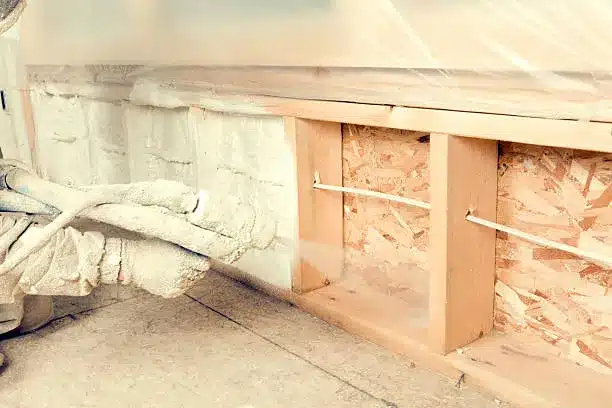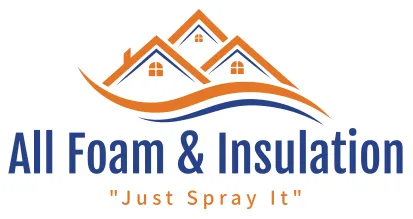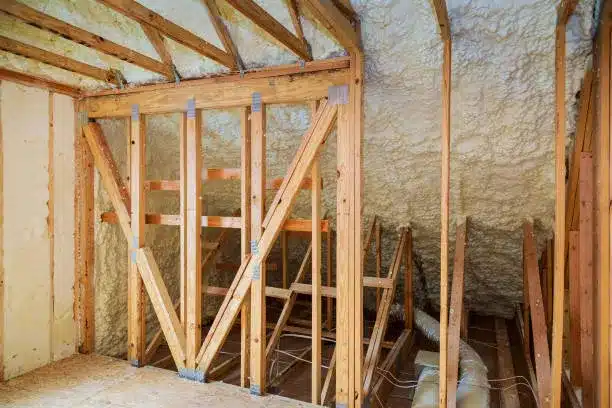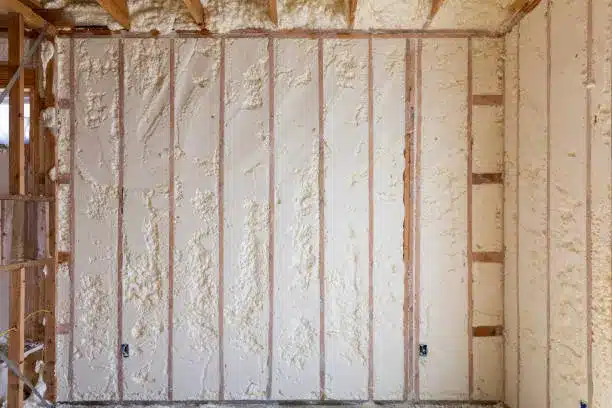Advanced open-cell spray foam insulation application stops air intrusion by creating a complete, seamless air barrier. When applied, the liquid material expands up to 100 times its initial volume, filling every crack, gap, and irregular cavity in a building’s structure. This expansion creates a custom seal that is impossible to achieve with traditional insulation like fiberglass batts or cellulose. The result is a significant reduction in uncontrolled airflow, which is a leading cause of energy loss and comfort issues in buildings.
This article breaks down how this material works, where it’s most effective, and what you should consider before using it. All Foam & Insulation has years of hands-on experience specifying and installing these systems, and the information here is based on that practical knowledge of building science and material performance.
How Open-Cell Foam Creates an Air Barrier
The effectiveness of open-cell foam as an air barrier comes from its physical properties and application method. Unlike rigid insulation boards or batts that must be cut to fit, spray foam is applied as a liquid that conforms perfectly to any shape. It adheres directly to studs, sheathing, plumbing pipes, and electrical wiring, leaving no gaps for air to pass through.
While the term “open-cell” might suggest air can move through it easily, that’s not the case. The interconnected cells create a very complex path that air struggles to get through. An analysis by the U.S. Department of Energy confirms that establishing a continuous air barrier is one of the most cost-effective ways to improve energy efficiency. Open-cell foam achieves this by forming a single, monolithic layer within the wall or ceiling assembly.
Bonus Tip: Proper installation is critical. The surfaces must be clean, dry, and within the correct temperature range. Any dust, oil, or moisture can prevent the foam from adhering correctly, compromising the air seal.
Key Differences in Spray Foam Insulation
Not all spray foams are the same. The choice between open-cell and closed-cell foam depends on the specific application, budget, and climate. Open-cell foam is softer, more flexible, and less dense, while closed-cell foam is rigid and dense.
Here is a direct comparison of their primary characteristics:
| Feature | Open-Cell Foam | Closed-Cell Foam |
|---|---|---|
| R-Value (per inch) | R-3.5 to R-3.8 | R-6.0 to R-7.0 |
| Air Barrier | Yes | Yes |
| Vapor Permeability | Permeable (Allows vapor to pass) | Impermeable (Blocks vapor) |
| Density | Low (0.5 lb/ft³) | High (2.0 lb/ft³) |
| Structural Strength | No, remains flexible | Yes, adds rigidity |
| Expansion | High (up to 100x) | Low (around 30-40x) |
| Cost | Lower | Higher |
The global spray foam insulation market is growing, with a report from Fortune Business Insights projecting continued expansion, driven by demand for energy-efficient building solutions. This trend highlights the industry’s move toward materials that provide both thermal resistance and superior air sealing.

Common Areas for Air Intrusion and How Foam Seals Them
Certain parts of a building are notoriously prone to air leaks. Open-cell spray foam is particularly effective at sealing these problem areas due to its expansive nature.
- Rim Joists: The area where the foundation meets the wooden frame of the house is a major source of air intrusion. Spray foam completely seals this irregular junction, including any gaps around sill plates and joist ends.
- Attic Assemblies: Whether applied to the attic floor or directly to the underside of the roof deck, foam stops the “stack effect.” This is where warm air rises and escapes through the attic, pulling cold air into the lower levels of the house.
- Wall Penetrations: Every hole drilled for plumbing, wiring, and HVAC is a potential air leak. Foam flows around these penetrations, creating a permanent, airtight seal that is difficult to achieve with caulk or tape.
- Cantilevers and Overhangs: Floors that extend beyond the foundation, like those for bay windows or upper levels, are often poorly insulated and sealed. Spray foam fills these exposed cavities completely.
Beyond Air Sealing: Additional Benefits
While stopping air leaks is its primary function, advanced open-cell foam offers other advantages that contribute to a building’s performance and comfort.
Superior Sound Dampening
The soft, pliable structure of open-cell foam is excellent at absorbing sound. Its texture disrupts sound waves, reducing airborne noise transfer between rooms and from the outside. The Spray Polyurethane Foam Alliance provides technical documents that detail the acoustic performance of spray foam, making it a good choice for media rooms, offices, and bedrooms.
Effective Moisture Management
Open-cell foam is vapor permeable, meaning it allows water vapor to pass through it. This is a significant benefit in many climates, as it enables the wall assembly to dry out if moisture gets in. By preventing moisture from getting trapped, it helps reduce the risk of mold growth and wood rot. In contrast, closed-cell foam acts as a vapor barrier, which can trap moisture in certain situations if not designed correctly.
Things to Consider Before Making a Decision
Before choosing open-cell foam, it’s important to evaluate a few factors to ensure it’s the right fit for your project.
- Climate Zone: In very cold climates (DOE Zones 6 and above), building codes often require a dedicated vapor barrier on the warm side of the wall. Because open-cell foam is vapor permeable, you may need to install a separate vapor retarder paint or membrane.
- Building Codes: All spray foam insulation must be protected by a 15-minute thermal barrier, such as half-inch drywall, according to the International Residential Code. It cannot be left exposed in living spaces or attics used for storage.
- Ventilation Needs: Creating an airtight building envelope is great for energy savings, but it also means you need a plan for fresh air. A mechanical ventilation system, like a Heat Recovery Ventilator (HRV) or Energy Recovery Ventilator (ERV), is often necessary to ensure healthy indoor air quality.
Bonus Tip: Always work with a certified installer. The performance of spray foam is highly dependent on the quality of the installation, which includes proper mixing, temperature control, and application thickness.
FAQS
Is open-cell foam a fire hazard?
It is a combustible material, but it is manufactured with fire retardants to meet building code safety standards. It must always be covered by an approved thermal barrier like drywall to separate it from the interior of the building.
How long does it last?
Polyurethane foam is chemically stable and inert once cured. When installed properly and protected from sunlight and physical damage, it should perform for the entire life of the building.
Can it be installed in an existing home?
Yes, but typically only in areas with open access, like unfinished attics, crawl spaces, or during renovations when wall cavities are exposed. It is not designed to be injected into closed walls that already contain insulation.
Is there an odor after installation?
A distinct odor is present during and immediately after application. Professional installers use powerful ventilation systems to manage this. The foam becomes fully cured and odorless within about 24 to 48 hours.
How does it impact indoor air quality?
Modern, professionally installed open-cell foams are designed to be inert and stable once cured. They do not off-gas or release harmful chemicals into the air, making them a safe choice for maintaining healthy indoor air quality.
Final Thoughts
Preventing air intrusion is one of the most effective strategies for creating an energy-efficient, comfortable, and durable building. Advanced open-cell foam offers a comprehensive solution by providing a near-perfect air barrier along with added benefits like sound control and moisture permeability. Before moving forward, evaluate your specific leakage points, climate requirements, and long-term performance goals to make an informed decision.
Get a Professional Assessment
Achieving a true air seal with spray foam requires specialized knowledge, equipment, and safety protocols. For property owners considering an insulation upgrade, a professional consultation is the essential next step. Contact All Foam & Insulation to schedule a thorough assessment of your building’s needs. The experienced team can be reached at (541) 826-9600 or via email at [email protected] to provide a detailed plan for your project.
Sources
- U.S. Department of Energy – Provides consumer information on the importance of air sealing for energy conservation.
- Fortune Business Insights – Market research report detailing the growth and trends in the spray foam insulation industry.
- Spray Polyurethane Foam Alliance – An industry organization that publishes technical documents and standards on the performance of spray foam, including its acoustic properties.




